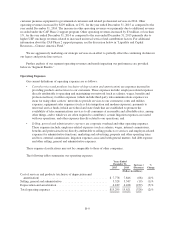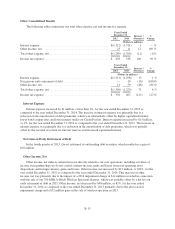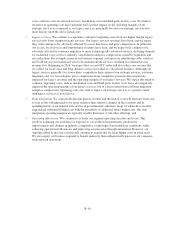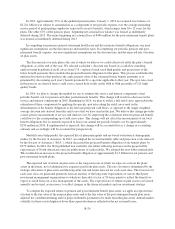CenturyLink 2015 Annual Report Download - page 127
Download and view the complete annual report
Please find page 127 of the 2015 CenturyLink annual report below. You can navigate through the pages in the report by either clicking on the pages listed below, or by using the keyword search tool below to find specific information within the annual report.Consumer Segment
The operations of our consumer segment have been impacted by several significant trends, including those
described below:
•Strategic services. In order to remain competitive and attract additional residential high-speed Internet
subscribers, we believe it is important to continually increase our broadband network’s scope and
connection speeds. As a result, we continue to invest in our broadband network, which allows for the
delivery of higher-speed broadband services to a greater number of customers. We compete in a
maturing broadband market in which most consumers already have broadband services and growth
rates in new subscribers have slowed. Moreover, as described further in Item 1A of our Annual Report
on Form 10-K for the year ended December 31, 2015, certain of our competitors continue to provide
high-speed Internet services at higher average transmission speeds than ours or through advanced
wireless data service offerings, both of which we believe have impacted the competitiveness of certain
of our high-speed Internet offerings. We also continue to expand our other strategic product offerings,
including facilities-based video services. The expansion of our facilities-based video service
infrastructure requires us to incur substantial start-up expenses in advance of marketing and selling the
service. Also, our associated content costs continue to increase and the video business has become
more competitive as more options become available to customers to access video services through new
technologies. The demand for new technology has increased the number of competitors offering
strategic services similar to ours. Price compression and new technology from our competitors have
negatively impacted the operating margins of our strategic services and we expect this trend to
continue. Operating costs also impact the operating margins of our strategic services, but to a lesser
extent than price compression and customer disconnects caused by competition. These operating costs
include sales commissions, modem costs, Prism TV content costs, software costs on selected services
and installation costs. We believe increases in operating costs have generally had a greater impact on
our operating margins of our strategic services as compared to our legacy services, principally because
our strategic services rely more heavily upon the above-listed costs;
•Legacy services. Our voice revenues have been, and we expect they will continue to be, adversely
affected by access line losses. Intense competition and product substitution continue to drive our access
line losses. For example, many consumers are substituting cable and wireless voice services and
electronic mail, texting and social networking non-voice services for traditional voice
telecommunications services. We expect that these factors will continue to negatively impact our
business. As a result of the expected loss of higher margin services associated with access lines, we
continue to offer our customers service bundling and other product promotions to help mitigate this
trend, as described below. Customer migration and price compression from competitive pressures have
not only negatively impacted our legacy revenues, but they have also negatively impacted the operating
margins of our legacy services and we expect this trend to continue. Operating costs, such as
installation costs and third-party facility costs, have also negatively impacted the operating margins of
our legacy services, but to a lesser extent than customer migration and price compression. The
operating costs also tend to impact our strategic services to a greater extent than legacy services as
noted above;
•Service bundling and product promotions. We offer our customers the ability to bundle multiple
products and services. These customers can bundle local services with other services such as high-
speed Internet, video, long-distance and wireless. While we believe our bundled service offerings can
help retain customers, they also tend to lower our profit margins in the consumer segment; and
•Operating efficiencies. We continue to evaluate our segment operating structure and focus. This
involves balancing our workforce in response to our workload requirements, productivity
improvements and changes in industry, competitive, technological and regulatory conditions. We also
expect our consumer segment to benefit indirectly from enhanced efficiencies in our company-wide
network operations.
B-19
























